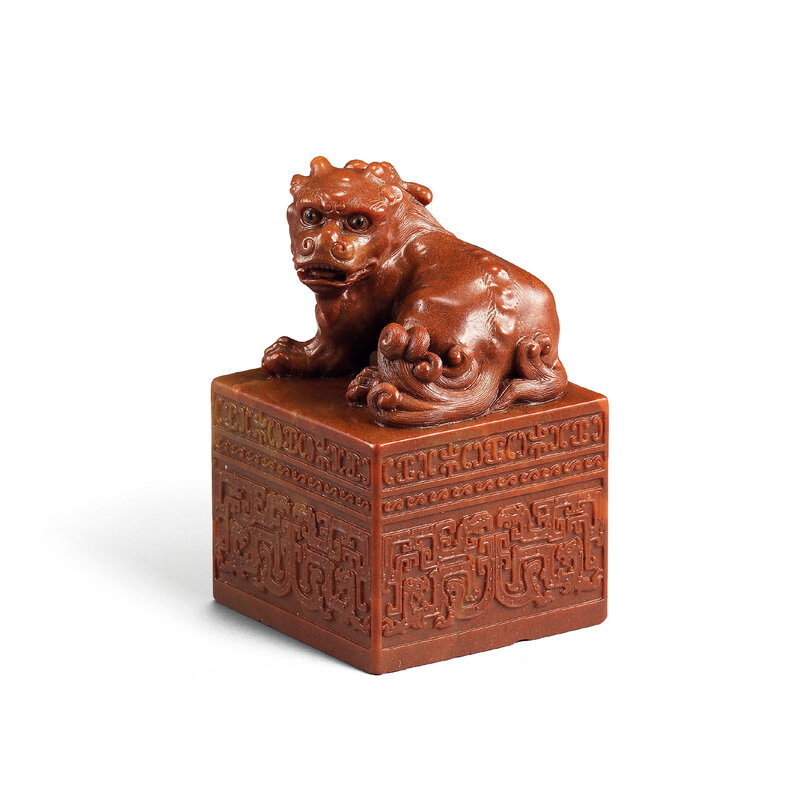Christie's. Leisurely Delights, Hong Kong, 29 May 2019
An imperial soapstone ‘Yuanjian huihao’ seal, Kangxi period (1662-1722)
Lot 3009. An imperial soapstone ‘Yuanjian huihao’ seal, Kangxi period (1662-1722); 2 5/16 x 2 5/16 x 3 5/8 in. (5.8 x 5.8 x 9.4 cm.), 605 g. Estimate HKD 15,000,000 - HKD 20,000,000. Price realised HKD 19,325,000. © Christie's Image Ltd 2019.
The columnar base is carved in shallow relief on the sides with a wide band of intertwined kui-dragons and kui-phoenix, below a narrow band of s-scrolls and a further band of ruyi-motifs, surmounted by a recumbent tri-horned mythical beast with finely detailed horns, back and tail, and inlaid eyes. The seal face is carved in relief with a four-character inscription, Yuanjian hui hao, ‘Wielding the brush in the Studio of Profound Discernment’. The stone is of a maroon colour with some russet mottling. Japanese wood box.
Provenance: Acquired in 1983 from a private collection, Kyoto, reputedly formed in the early 20th century.
Note: The impression of the current seal is included in Qingdai dihou xiyin jicheng [Catalogue of Imperial Seals of the Qing Dynasty], vol. 1, Beijing, 2005, p. 99 (fig. 1); and in Qingdai dihou xiyin pu [An Album of Impressions of the Qing-dynasty Emperors and Empresses’ seals], vol. 3, Kangxi juan, p. 21.
fig. 1 Impression of the current seal included in Qingdai dihou xiyin jicheng [Catalogue of Imperial Seals of the Qing Dynasty], vol. 1, Beijing, 2005, p. 99.
The Kangxi Emperor, personal name Xuanye, was the second Qing emperor to rule over China, and the longest-reigning ruler in Chinese history. Kangxi Emperor is considered one of China’s greatest rulers, for having established long-term stability and relative prosperity after years of war and chaos, and for initiating the Prosperous Era of Kangxi, Yongzheng, and Qianlong. In addition to being an able ruler, the Kangxi Emperor was also a learned scholar, devoting much of his leisure time to reading and writing calligraphy. The present seal bears a four-character inscription Yuanjian huihao, ‘Wielding the brush in the Studio of Profound Discernment’, and was carved especially for the Kangxi Emperor to impress on his personal calligraphic works composed at the Studio of Profound Discernment.
Yuanjianzhai, ‘Studio of Profound Discernment’, was located inside Changchunyuan, a Qing imperial garden to the northwest of the Forbidden City. The Kangxi Emperor commissioned the construction of Changchunyuan in 1684 after he returned from the first Southern Expedition. Between 1687 when the Kangxi Emperor first resided at Changchunyuan to his death in 1722, the Emperor spent more than half of each year each year at Changchunyuan where he attended to political affairs in a serene environment. Yuanjianzhai was the most important studio within the Changchunyuan during the Kangxi reign. Many of the most significant imperially-commissioned publications were named after Yuanjianzhai, including the Yuanjianzhai yuzuan Zhuzi quanshu [The Yuanjianzhai Imperially Compiled Complete Collection of Zhu Xi], Yuanjian leihan [The Yuanjian Encyclopedia], Yuanjianzhai fatie [The Yuanujianzhai Anthology of Emperor Kangxi’s Calligraphy Works], and Yuanjianzhai guwen xuan [The Yuanjianzhai Selected Anthology of Ancient Text]. Yuanjianzhai was also the place where the Kangxi Emperor practiced calligraphy. Passionate about calligraphy and pleased with his own achievement, the Kangxi Emperor mounted his calligraphy in various formats according to their sizes, from albums, hand scrolls to hanging scrolls, with each work impressed with his personal seals chosen to correspond to the size of each respective calligraphy work. The current seal was used as a corner seal on the Kangxi Emperor’s larger calligraphic works mounted as hanging scroll, as seen on two calligraphic works preserved in the Palace Museum, Beijing, A Tang poem about the lotus in bloom, written in running script in the style of Dong Qichang (fig. 2), and A Tang poem in praise of chrysanthemums, written in the standard running script in the style of Mi Fu, where the current seal is impressed on the lower left corner together with another four-character seal Wuwei zaihe, ‘Five Senses in Harmony.’ Out of all the Kangxi Emperor’s imperial seals, totalling more than 130, very few of them bear inscriptions named after architectural complexes, with the exception of those associated with Yuanjianzhai. In addition to the current seal, four other seals bearing the inscription Yuanjianzhai have been recorded, testifying to the importance of Yuanjianzhai to the Kangxi Emperor, and its role as a recluse for the Emperor to indulge in his artistic output.
fig. 2 Collection of the Palace Museum, Beijing
The angular style of the archaistic motif on the sides of the seal is also found on a contemporary Songhua ink stone cover in the National Palace Museum, Taipei, illustrated in A Special Exhibition of Sunghua Inkstone, Taipei, 2008, p. 89, no. 20 (fig. 3), both examples showcase the finest craftsmanship of the Imperial ateliers of the Kangxi period.

/https%3A%2F%2Fprofilepics.canalblog.com%2Fprofilepics%2F1%2F0%2F100183.jpg)
/https%3A%2F%2Fstorage.canalblog.com%2F03%2F02%2F119589%2F96711876_o.jpg)
/https%3A%2F%2Fstorage.canalblog.com%2F11%2F31%2F119589%2F94773502_o.jpg)
/https%3A%2F%2Fstorage.canalblog.com%2F20%2F83%2F119589%2F94772815_o.jpg)
/https%3A%2F%2Fstorage.canalblog.com%2F26%2F72%2F119589%2F75604929_o.jpg)
/https%3A%2F%2Fstorage.canalblog.com%2F59%2F60%2F119589%2F26458628_o.jpg)








/image%2F1371349%2F20240331%2Fob_0d7487_2024-nyr-22642-0859-000-an-unusual-sma.jpg)
/image%2F1371349%2F20240331%2Fob_a6f470_2024-nyr-22642-0857-000-a-large-black.jpg)
/image%2F1371349%2F20240329%2Fob_2f6b6c_854-1.jpg)
/image%2F1371349%2F20240329%2Fob_825c4d_2024-nyr-22642-0851-000-a-rare-black-g.jpg)